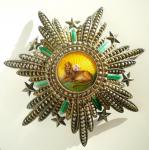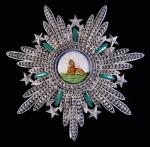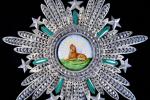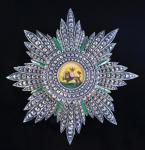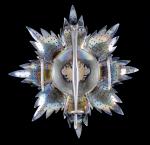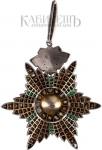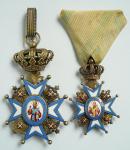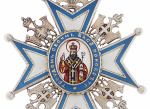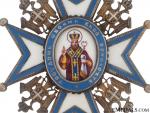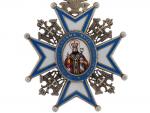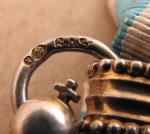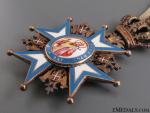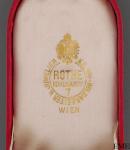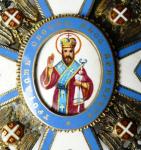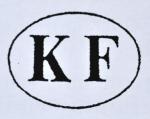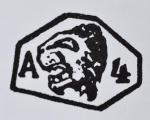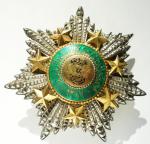-
Posts
821 -
Joined
-
Last visited
-
Days Won
8
Content Type
Profiles
Forums
Blogs
Gallery
Events
Store
Everything posted by Markus
-

Persia - Order of the Lion and the Sun
Markus replied to drclaw's topic in Middle East & Arab States
Another Early Lemaitre 2nd class Lion and Sun breast star without nameplate, but it does have French Boar mark and a Lemaitre punch mark on the pin. Lemaitre also made their medals for Boullanger and I have identical style Lion paintings with the Boullanger nameplate affixed. -

Persia - Order of the Lion and the Sun
Markus replied to drclaw's topic in Middle East & Arab States
A Lemaitre made 2nd class breast star with stars affixed between the rays. This was an earlier style breast star and later the stars between the rays were discontinued. Lemaitre changed to the 40 Rue Coquilliere address listed on the name plate in 1870. -

Persia - Order of the Lion and the Sun
Markus replied to drclaw's topic in Middle East & Arab States
A beautiful Halley made Lion and Sun 1st class breast star with a Military style lion. The address on the nameplate 143 Galerie de Valois, Palais Royal is the first address for Halley placing this Breast Star being made during the reign of Napoleon III, 1860-1870 range. -

Serbia Order of the Star of Karađorđe with Brilliants
Markus replied to paja's topic in Southern European & Balkan States
Wow! Thanks for posting this beauty Radmilo! -

Persia - Order of the Lion and the Sun
Markus replied to drclaw's topic in Middle East & Arab States
Thanks Professor Nick! Now I can add this to my ever expanding list of Persian Lion and Sun makers! I suspect we have a long way to go on Russian makers of the Lion and Sun. -

Serbia Austrian Made St. Sava's
Markus replied to Markus's topic in Southern European & Balkan States
Yes the photo of the backside clearly shows an M monogram that is too small for the space. All the other type M monograms filled that white space on the enamel. Maybe there have been parts replaced by a collector or jeweler on these type I Bertrand's. Very nice thread Gents! -

Serbia Austrian Made St. Sava's
Markus replied to Markus's topic in Southern European & Balkan States
Hi Radmilo, Interesting that Bertrand had type I Sava' s as well. They must have starting working on them prior to the dynasty shift for sure. The book source I was using didn't have Bertrand samples with the M monogram, but does mention Bertrand started production on Serbian orders just before the Balkan wars. The two samples you posted with Bertrand style paintings, also look very Bertrand style to my eye, especially with the type of crown painting. The vast majority seems to have been type II production, so I think your samples are quite rare! Sorlini producer for type II also seems to be rare. What a wild looking painting on the Sorlini! -

Serbia Austrian Made St. Sava's
Markus replied to Markus's topic in Southern European & Balkan States
Paja is correct. Bertrand was a French jewelery company founded in 1863 and they produced many order medals for countries around the world. They are still producing today. The address on the box (nice box! This type box was generally used by Bertrand to deliver the Serbian White Eagle order and a blue colored box was used to deliver the St. Sava order) was in use until 1917 so this dates the medal to being produced from 1903-1917. Bertrand produced the type II St. Sava medal for the Serbian government, with the design changed on the back of the medal eliminating the "M" monogram and replacing it with the year numerals of 1883, the year the order was founded. Type II, St. Sava were produced during the Karageorgevich dynasty from 1903-1918 by only two producers, Bertrand and Scheid. Bertrand produced a large number of St. Sava's for the Serbian government to award WWI participants. Many different painters were used by Bertrand to meet the production demand, so many style paintings for Bertrand St. Sava's could be found. Some are quite nice, like your example, and other are primitive in execution. Markus -

Persia - Order of the Lion and the Sun
Markus replied to drclaw's topic in Middle East & Arab States
A jeweled Russian made 3rd class Lion and Sun. I would have mistaken the medallion painting for a Persian made one. Russian hallmarks on the back. -

Serbia Austrian Made St. Sava's
Markus replied to Markus's topic in Southern European & Balkan States
Nice additions Radmilo! I could look at these all day! Thanks! There are so many different style St. Sava paintings, even in just looking at Austrian made ones. -

Serbia Austrian Made St. Sava's
Markus replied to Markus's topic in Southern European & Balkan States
-

Serbia Austrian Made St. Sava's
Markus replied to Markus's topic in Southern European & Balkan States
This medallion paintings is Type II Scheid produced. The painting looks more simplified in form and is from the later years, when Scheid simplified the paintings. -

Serbia Austrian Made St. Sava's
Markus replied to Markus's topic in Southern European & Balkan States
This is the Type II St. Sava by Scheid workshop. Scheid seems to be the most prevalent Austrian maker of type II St. Sava's. Photos by Emedals. -

Serbia Austrian Made St. Sava's
Markus replied to Markus's topic in Southern European & Balkan States
The Workshop of George Adam Scheid was founded in Vienna in 1882. The products of Scheid's workshop were marked G.A.S.on medal rings and a mark of G.A.SCHEID-WIEN was stamped on pins and stars. The Scheid workshop joined in production of the Serbian orders after 1890 and his workshop produced almost all of the Serbian royal orders. Scheid's workshop continued to produce Serbian orders, after the Austrian/Serbian relations had cooled with the May Coup, and the other Austrian medal producers ceased production for Serbia. The Scheid workshop was one of the last series of workshops to produce the St. Sava order in the Obrenovich Dynasty. In the first years of producing the St. Sava, the Saint Sava paintings on the medallions was very detailed and finely painted. In later years in producing the second type of St. Sava, the paintings were simplified. It is interesting that the Scheid firms legacy lives on with the former medal foundry he founded eventually becoming the Austrian State Refinery For Precious Medals. Georg Adam Scheid died in 1921 and his firm went bankrupt in 1922. Attached is a Scheid made Commander type I, St. Sava. Photographs by Emedals. Information sourcing from Serbian and Yugoslavian Orders and Decorations, by Pavel Car and Tomislav Muhié. -

Serbia Austrian Made St. Sava's
Markus replied to Markus's topic in Southern European & Balkan States
Hi Igor, No I just used the case as an example for Rothe cases. Markus -

Serbia Austrian Made St. Sava's
Markus replied to Markus's topic in Southern European & Balkan States
The Rothe & Neffe workshop was the first producer of the Order of St. Sava in the Obrenovich Dynasty. As other Austrian medal workshops were commissioned to produce the St. Sava order as well, the Rothe & Neffe medals were less frequently seen. Rothe & Neffe were one of the most famous names in the world of fine arts and many Royal houses in Europe commissioned Rothe & Neffe to produce their order medals. The Rothe & Neffe workshop was well known for producing the highest quality medals and produced with exacting standards faithful to the specifications demanded by the orders blueprint. The makers hallmark were stamped generally into the medal ring, the letters, "FR"( the initials of Friedrich Rothe). The medallion portrait paintings of Rothe & Neffe were of the highest quality and detail and did not vary that much throughout their production. The Rothe & Neffe workshop delivered their medals in their own case, red color with the Serbian coat of arms stamped in gold on the cover. Later the firm became known as C.F. Rothe. The firm had a very long life from beginning in 1849 to it's slow demise in the 1980's with the end of the demand for high quality Order medals with old world craftmanship. This is a type 1, 4th class St. Sava produced by the Rothe & Neffe workshop with an "FR" stamped on the ring. Purchased this medal from Emedals. Information sourced from the book, Serbian and Yugoslavian Orders and Decorations, by Pavel Car & Tomislav Muhié. Photos by Emedals. -

Serbia Austrian Made St. Sava's
Markus replied to Markus's topic in Southern European & Balkan States
Roji, Thanks for posting your St. Sava in an earlier thread. I enjoyed the topic and share your enthusiasm for this beautiful order medal! Markus -

Serbia Austrian Made St. Sava's
Markus replied to Markus's topic in Southern European & Balkan States
Radmilo, the different crown issue is indeed interesting. I think it must have been a production related issue. Perhaps they ran out of the regular crown of St. Sava medals and substituted a crown from another one of their productions or someone pulled the wrong crown element from their supply without noticing it was a different variety. The medal workshops produced many different country order medals, so a mixup is conceivable. The issue of different crowns only surfaced with a portion of their product and wasn't a permanent change. It is probably one of those mysteries that we will never know. Markus -

Persia - Order of the Lion and the Sun
Markus replied to drclaw's topic in Middle East & Arab States
-

Serbia Austrian Made St. Sava's
Markus replied to Markus's topic in Southern European & Balkan States
Thanks Radmilo for the close ups of the Maker marks and silver mark! My next St.Sava will be a Rothe made St.Sava, as soon as it arrives. My macro lens does not get all that close, so the marks didn't show that well. -
I have always appreciated the Order of Saint Sava for one of the most beautifully designed medals. In this thread I wish to explore Austrian made St. Sava and examine the different Austrian maker types. First I will start with a Karl Fleischhacker made Commander medal. "Karl Fleischhacker received his license in 1891 and established a firm at Peyerlgasse 4 and later on at No.7, in the 16th district of Vienna. This was the firms address until 1908 when it closed down. Business with the Kingdom of Serbia probably started soon after the firm had been established in the 1890's, when Fleischhacker took over the production over all Serbian royal orders. Karl Fleischhacker had a major influence on the production of Anton Fürst and Jacob Lesser." ( From the book, Serbian and Yugoslavian Orders and Decorations by Pavel Car and Tomislav Muhié.) The makers mark for Karl Fleishhacker is an oval with the letters KF inside. Karl Fleischhacker did not produce his own packaging and used Maksim Antonijevich for packaging and delivery. The cases were a standard red color. The medallion painter for this workshop produced very high quality paintings and Karl Fleischhacker was known for the highest Viennese quality in production. This particular III Class commander medal was produced in the Obrenovich Dynasty 1883-1903 and is the first type in production with the Monogram "M" on the back.The "M" was a monogram for King Milan I Obrenovich and this was changed to 1883 during the Karageorgevich Dynasty (1903-1918). One interesting anomaly that this badge exhibits, is a different type crown than others that were produced by the Fleischhacker workshop and this larger crown is known to be included in a portion of Fleischhacker production of St. Sava medals. The crown is wider and larger resembling a crown that could be found on the Order of San Marinus (Republic of San Marino). just below the crown are two hallmarks that were stamped into the link attaching medal to crown, KF in an oval and the Silver Mark of a lion greyhound head with the letter "A" and "4". This was the Austrian Silver mark for silver fineness 750. I have noticed that the balls on the tips of the Maltese cross seem a bit larger on earlier production types of St. Sava. The earlier medallions of St. Sava were all hand painted by artists and slight variations can seen even with the same workshop. It appears that Karl Fleischhacker used the same artist to paint all his St. Sava's.
-
Thanks Emmanuel, I was using the same site to look up the date, but mistakingly was in the wrong city section. You are correct!
-
Jordan Order of the Star (Wisam al-Kawkab al-Urdani) founded in 1949 by King Abdullah I. Usually given by head of state King Abdullah for extraordinary achievements, to military and government officials. This is an early set made by Garrard in Birmingham England in 1966. The pieces are very heavy and substantial, made of silver. The maker marks and British silver markrs of anchor, Lion, and R are stamped on the back. The Anchor represents the city of Birmingham, the R represents the year 1966 in the British silver marking system. The later made medals Order of the Star were made by Bertrand, Huguenin and Bichay in Egypt.
-
Well said Gavin! Thanks to all the GMICers, I have had such a great time reading all the posts and learning quite a bit. Merry Christmas to all!
-
Wow, just awesome! Merry Christmas and have a great New Year Nick! Always enjoy your many contributions to this forum. You are truly a class act! Markus


